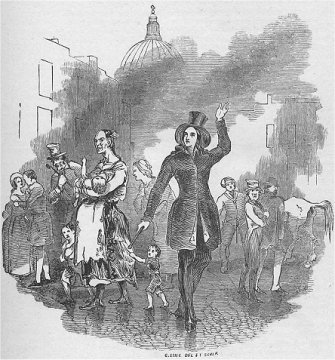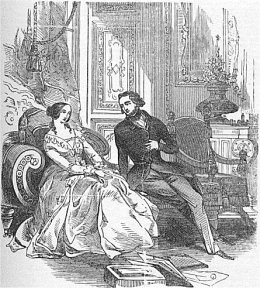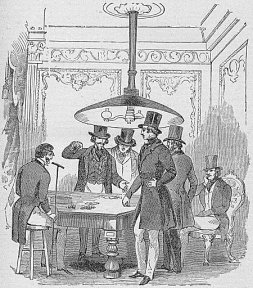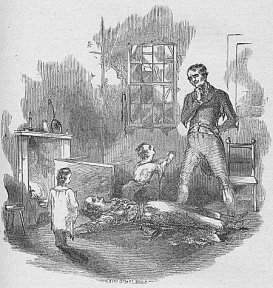
Official Edgar Rice Burroughs Tribute and Weekly Webzine Site
Since 1996 ~ Over 10,000 Web Pages in Archive
Volume 1797

|
by R.E. Prindle |
The Mysteries Of The Court Of
London
First Series
by
George W. M. Reynolds

|
Danton Burroughs ERB Archive ~ Tarzana, California www.ERBzine.com/dan Shelf R1 |
Collecting is a peculiar form of insanity.
I had it in boyhood,
Stamps, coins and postmarks.
Stamps, coins and postmarks. Looks like the bug had a pretty firm grip on Our Man In Tarzana. As one of the afflicted I have to agree with ERB. Collecting is a form of insanity. I think it even possible to depict collecting as a disease on the same order as alcoholism, kleptomania or obesity Definitely a personality disorder. It's about time we had medical recognition and federal financial assistance. Our problem wouldn't get any better but we'd have more money to indulge. it. Why send all that money overseas when it could be better spent at home?
I don't know if I have ever been ashamed of the affliction but I have certainly been embarrassed by it. ERB is being slightly disingenuous when he modestly says he had it in boyhood. How did he cure himself? Endless hours of analysis or did he take the twelve point program of Collector's Anonymous? You know what I'm talking about, don't you?
I know how he felt. I conquered my collecting mania too. There are all kinds of things I no longer collect. But ... my library does keep growing. I might as well confess it all; I've got that under control too. I no longer just buy books to be buying books; I only buy books for functional purposes now. Of course my mind has a very broad definition of functional. My most recent purchase was George W.M. Reynolds' Mysteries Of The Court Of London. What a buy! One title but it comes in ten volumes. Another two feet of nonexistent shelf space eaten up. Did I like the book? Oh yeah! What an unexpected bonus.
The set was found in Burroughs' library so I wasn't too surprised that I liked it. I've found that Burroughs has impeccable literary taste. I'm pretty broad on literary too. Of course that it is in the library is why I obtained the set myself. I really like the picture of Burroughs - the man who conquered the collecting mania - sitting at his desk in front of a massive array of completely filled shelves. One more won't hurt as the alcoholic said. Yeah, sure, ERB used to suffer from that peculiar form of insanity. He tries to dignify his book collecting by saying he no longer reads fiction. He only read fiction as a kid too. Cured himself of fiction at the same time as collecting, I suppose. Ah. the 'sins' of our youth.
Does he really think buying non-fiction rather than fiction means he's not collecting? Listen to ERB in his own words trying to justify and dignify his book collecting. LA Times 1/7/23:
And then there are magazines such as the Geographic, Asia and Popular Mechanics. These three constitute an encyclopedia of liberal education for adult or child that arouses a desire for more knowledge and fosters the habit of reading.'Arouses a desire for more...' I get it. Yes, ERB does collect but there's a good reason for it as well as the real reason. He's improving his mind. I know where that excuse is at and it beats drinking. You can bet the old boy was lugging several hundred pounds of magazines as he moved fifty times in fifty years or thereabouts. Geographics are heavy in more ways than one.You see he was getting a liberal education. He was reading high tone stuff (haut ton in French) like the National Geographic, (spoken familiarly) as the Geographic, Asia, (nice touch, shows breadth of interest) and Popular Mechanics (proletarian touch). The trio of magazines pretty well reflects the contents of his own novels. Well, what about fiction?
I am fond of fiction, too, although I don't read a great deal of it.No. However...And I have my favorites. Mary Roberts Rhinehart and Booth Tarkington are two of them. When I read one of Mrs. Rhinehart's stories I always wish I had been sufficiently gifted to have written it, and then when I read something of Tarkington's I feel the same way about that. I have read "The Virginian" five or six times (this is in twenty years) and "The Prince And The Pauper" (N.B.) and "Little Lord Fauntleroy" as many.Gee. That's all literary fiction; how about the guys he really liked: Baum, London, Haggard, Doyle, Sue and Reynolds for instance. Too close to pulp, not enough dignity to mention in a Times article. The amount of fiction he read from 1920 to 1924 was fairly impressive.My studies have compelled me to read a lot of fiction in the attempt to understand ERB and let me say this, the man had unerring taste in exciting fiction. The Mysteries Of The Court Of London is one heart pounding book. No one would ever confuse it with the National Geographic, Asia or Popular Mechanics though.
Reynolds could ramble on too. The work is composed of two series of five volumes, each series twenty-five hundred pages. The internal evidence in Burroughs' work is that he read it before 1910. There are at least three clear references to the First Series. The house on the Thames that Norman and De Vac lived in was based on the mid-wife's house. The segment of the Mysteries concerning the Monster Man contributed a great deal to ERB's Monster Men, while the abduction of the baby by the Monster Man lent itself to baby Jack's abduction in The Beasts Of Tarzan. Burroughs' vision of London, which he never saw, is probably drawn from Reynolds although various other British authors such as Doyle would also have been influences.
The series of novels would have been only fifty years old when Burroughs read it ,so he was fairly close to the times if seven thousand miles or so from the location.
I couldn't find a Reynolds Society on the internet although the books are not that easy to find nor all that cheap. I bought the only complete set offered, otherwise it would have been impossible to assemble a complete set from the partial list offered. Reynolds must therefore be in demand by the cognoscenti.
George Reynolds was born in 1814, two years after Dickens, being 32-35 years old when he wrote this huge work. To write such an extended novel requires a capacious and inventive mind. The novel comprises hundreds of characters and thousands of incidents each individual in its depiction. That Reynolds should have had the experience and the ability to organize it as the novel indicates at such a young age is nothing short of amazing.
Politically Reynolds was a Red. He was affiliated with a political organization called Chartism. As the novel was written in magazine installments to coincide with the Revolution of 1848 the appearance is that Reynolds' intent was to irritate the people into open rebellion. If so, he failed. He was opposed to the monarchy and called for its abolition. The work is a diatribe against George III and George IV. Reynolds' hatred of the pair actually disfigures the novel. He compares George III to Caligula and Nero but fails to show in what way the monarch resembled either Roman. As Reynolds was born in 1814 while George IV died in 1830 and the events covered are in 1798 and 1814 he couldn't have been a witness of the times.
In his lifetime Reynolds was more popular than Dickens. Perhaps the topicality of this novel precluded the success Dickens has enjoyed. The comparison would be that between Phil Ochs and Bob Dylan. While the novel was reprinted in limited editions to at least 1912 there is currently no new reprint available.
I find the novel compelling; to use the old cliche, the novel is a page turner volume after volume, thousand pages after thousand pages. The work is masterfully planned, events in the first dozen pages are worked out fifteen hundred pages or more later. Indeed the central mystery is concluded at the end of the work five thousand pages later. The detail and variety never tire. The mystery and detective elements preshadow Doyle and the entire twentieth century. Police personnel turn over on a regular basis, everything is always fresh and sparkling. Scenes and characters are vividly drawn.
Although Burroughs drew the line at modern sex novels, Mysteries is a sex novel par excellence. The entire novel is drawn against the sexual escapades of the characters. If you like mildly smutty novels this one is for you. The influence of the novel on Burroughs may be most pronounced in this respect. Reynolds goes into detailed studies of male-female relations. Each volume of the first series is subtitled after a heroine. Thus the action depends on the harassment of worthy females by, well, lecherous unprincipled men. The worst of the lot and the character who holds the novel together is Prince George the future Regent and King.
Reynolds' men stop at nothing when they come across a desirable female, abduction, threats, force, in a word, rape is their stock in trade. They are aided by procuresses who run establishments in the most respectable shopping districts that double as brothels.
While Reynolds is not as graphic in his sex scenes as writers are today his descriptions of capacious bosoms is tantalizing enough. His ladies must have had strange diets because he speaks of 'glowing orbs'. Quite tactile in his way. Frazetta would have had a field day illustrating Mysteries. Reynolds' descriptions reminded me of nothing so much as Frazetta's women. Frazetta's own voluptuous but virtuous portrayals were based on Burroughs descriptions so I would have to think Burroughs' imagination was fired by this endless procession of stunningly voluptuous beauties.
Then too, the frequent abductions and threats of 'fates worse than death' by the villains in Burroughs' work exhale the aroma of Mysteries.
Reynolds' use of darkness and labyrinthine passages, locked doors and whatnot seem to be reflected in Burroughs' work. One most appealing trait of Reynolds that ERB must have enjoyed was the former's use of slang and thieves cant. Burroughs also delights in underworld slang and various dialects.
This immense work can be considered a very early roman a fleuve not unlike some of Dumas' work or even as a prototype of Marcel Proust's. I believe Burroughs saw it that way. Seen that way Burroughs created four roman a fleuves influenced by Reynolds' Mysteries. Tarzan, the Mars Series, Pellucidar and the Venus Series.
The Russian Quartet of Tarzan may be based directly on Mysteries from the nautical scenes to London and Paris. Indeed, the Quartet may be considered a separate roman a fleuve within the Tarzan oeuvre. His portrayals of London and Paris show Reynolds' influence.
Just as Reynolds' volumes in this novel portray a series of adventures cut off after about five hundred pages then resumed in the next volume, Tarzan's adventures beginning with the Jewels Of Opar display the same characteristic. After the Russian Quartet Tarzan is just one long novel or roman a fleuve.
The Venus series is just a long story broken up into five volumes. It could just as easily be bound in one volume with consecutive pagination and you wouldn't be able to tell the difference.
The John Carter on Mars series exhibits the same traits although less clearly. Pellucidar is nearer in concept to the Venus series. So all the series show an endless series of barely connected adventures held together by a common cast of lead characters with the stories going nowhere. They just end. Princess Of Mars is the most obvious case. Mars just runs out of air like a flat tire which might mean that Burroughs just didn't have an ending or that he had temporarily run out of ideas and had to recharge.
While Burroughs is charged with using coincidence to excess, once again he may have just been emulating Reynolds. The latter is shameless in his use of coincidence. At one point while visiting a dangerous villain in a lawless area Reynolds' detective, Larry Sampson, needs a disguise. A disguise store is very conveniently located just across the street. The owner is in cahoots with Sampson even though doubling as a criminal. He provides Sampson with a disguise and the story continues. Is it any wonder that two or three shipwrecks occur on the same stretch of coast on which Tarzan's parents landed. Burroughs learned the use of improbable coincidence from a master.
So in addition to borrowing specific incidents from Reynolds Burroughs also borrowed the basic plan. Combining Mysteries Of The Court Of London and The Mysteries Of Paris one gets down to the bedrock of Burroughs influences. But the man's ability to absorb influences and incorporate them into his work from the beginning indicates that the man was a real book worm. As we know he was also an athlete the man must never have had an idle moment.



WEB REFS
Mysteries of London ~ eText Edition with illustrations (partial)
ERB Personal Library Project
ERB Shelf R1: George W. M. Reynolds
Wikipedia Entry
|
Volume 1797a Art ~ Chapter Titles ~ eText ~ Poetry ~ Song Volume 1797 Volume One of the Review from The Mysteries Of The Court Of London |
R. E. Prindle welcomes your comments at:
dugwarbaby@yahoo.com
|
and Follow the Navigation Chart for the Entire Series of Articles |
|
Differing viewpoints are welcome. |
|
are not necessarily those held by Edgar Rice Burroughs, Inc. |
![]()
![]()
![]()
![]()

![]()
BILL
HILLMAN
Visit
our thousands of other sites at:
BILL
AND SUE-ON HILLMAN ECLECTIC STUDIO
ERB
Text, ERB Images and Tarzan® are ©Edgar Rice Burroughs, Inc.-
All Rights Reserved.
All
Original Work ©1996-2007/2010 by Bill Hillman and/or Contributing
Authors/Owners